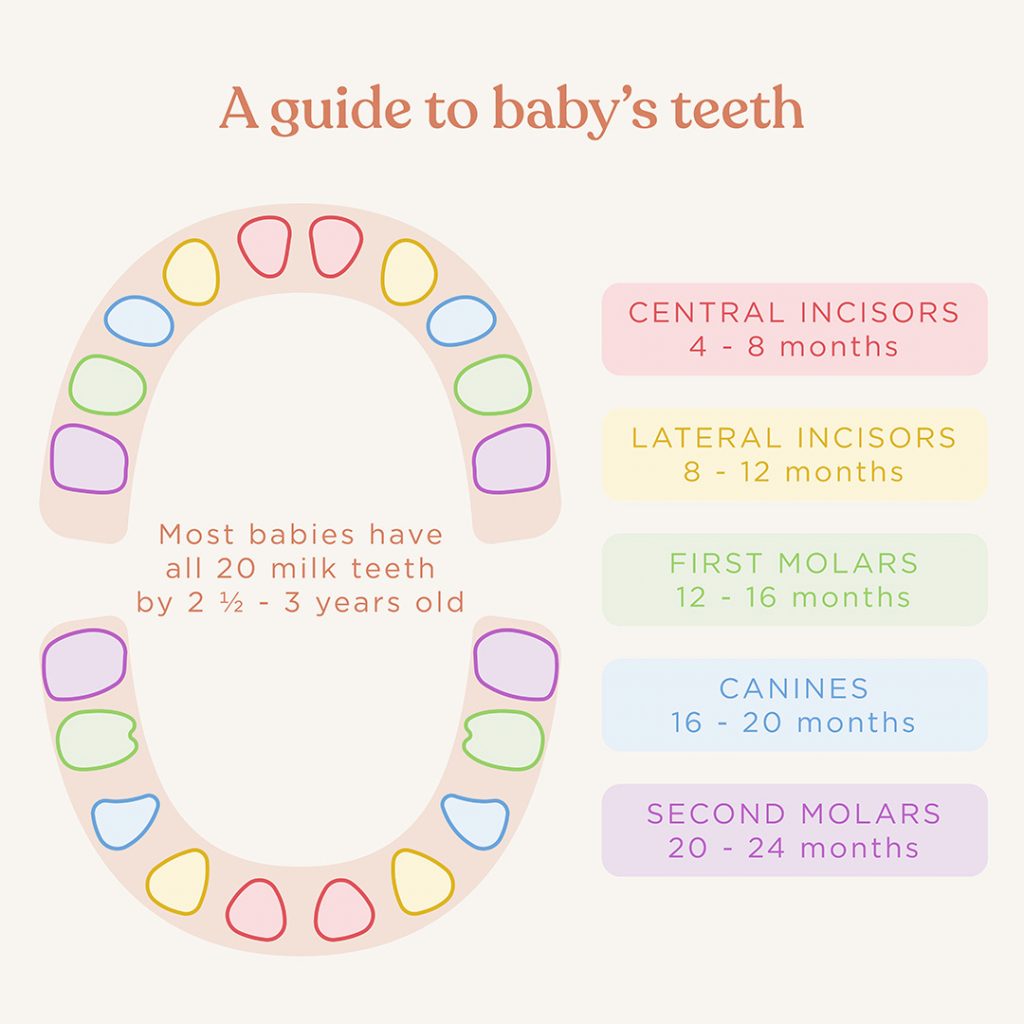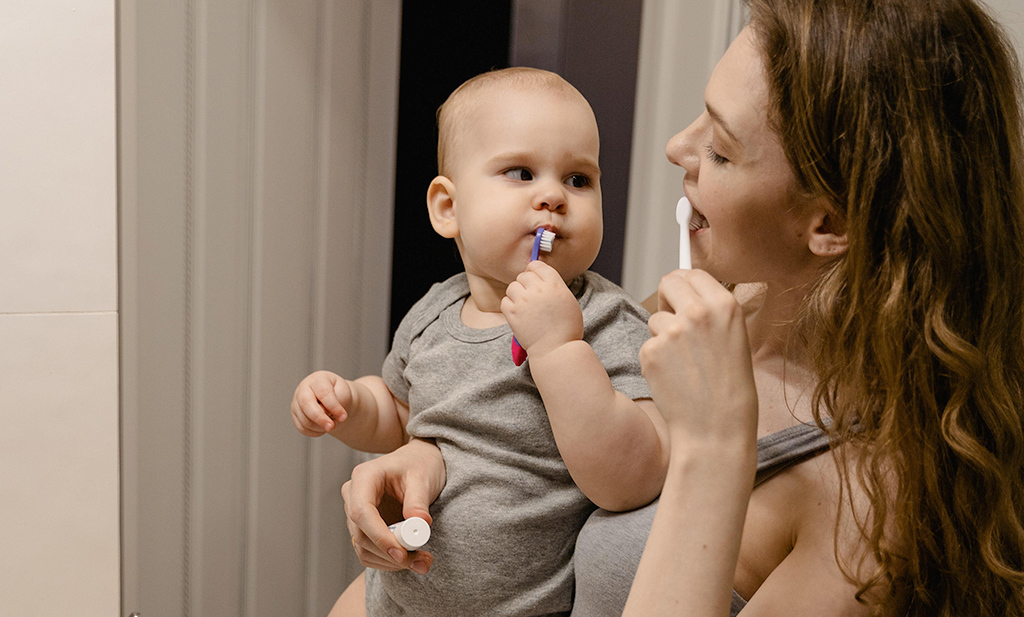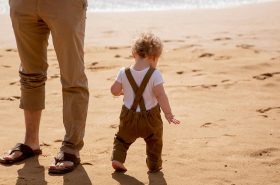
Did you know that the development of a child’s teeth begins in early pregnancy? However, it takes until infancy for the first teeth to become visible. But what about brushing your baby’s teeth? Baby teeth need different care than those of children or adults. Since the foundation for a healthy dental life is laid in infancy and toddlerhood, our midwife and babywearing consultant Katrin Ritter answers the most frequently asked questions about baby’s teeth, teething and dental care.
When does a baby grow their first tooth?
On average, the first milk teeth appear between the sixth and eighth month of life. However, for some babies, the first tooth appears at the age of three or four months, for others there is still no tooth in sight on their first birthday. Every child is different – so don’t stress about this.
Which teeth come first?
As a rule, teeth erupt according to the following pattern, but the timing can be individual:
– 4 to 8 months: central incisors at the bottom, then at the top.
– 8 to 12 months: lateral incisors on top, then on the bottom.
– 12 to 16 months: front molars on top, then on the bottom.
– 16 to 20 months: canines above, then below.
– 20 to 24 months: upper molars, then lower.

How many teeth does a baby have?
The child’s dentition consists of 20 teeth, with 10 teeth each in the upper and lower jaw. In each jaw, the child grows four incisors, two canines and four molars. The primary dentition is complete when your little one has 20 teeth – normally by around two and a half to three years old.
When should you start brushing your child’s teeth?
Has your little ones first tooth arrived? Then it’s time to start brushing carefully once or twice a day with a soft, moistened toothbrush and a small smear of toothpaste until they are three years when old a pea-sized amount of toothpaste should be used. Use children’s fluoride toothpaste containing no less than 1,000ppm of fluoride (check the label) unless a dentist advises family toothpaste containing between 1,350ppm and 1,500ppm fluoride. The point is to get your baby used to the toothbrush and dental care should be part of the daily routine in the evening before bedtime and one other time of the day. You should brush for about two minutes and spit out after brushing, without rinsing.
Make sure that your child does not swallow the toothpaste and parents or carers should brush the teeth until children are aged around 7 years old but even then it’s a good idea to keep an eye on them to make sure they brush properly and for the full two minutes.

How can I tell that my baby is teething?
While teething is noticeable in some babies with a bad mood, difficulty sleeping, clinginess or red cheeks, in others the little teeth come quietly and secretly. Symptoms such as increased salivation and the need to constantly put something in their mouths are common to most babies. The increased drooling can also irritate the skin on the face. Some children also suffer from slightly increased temperature. Some people think that teething causes other symptoms, such as diarrhoea, but there’s no evidence to support this. You know your baby best. Get medical advice if they have any symptoms that are causing you concern.
What can you do for teething pain?
If your baby suffers a lot during teething your paediatrician can recommend various remedies including:
– Teething gel: There’s a lack of evidence that teething gels are effective. It’s recommended that parents try non-medical options for teething first, such as a teething ring. If you do decide to use a gel, check out the NHS guidance first: https://www.nhs.uk/conditions/baby/babys-development/teething/tips-for-helping-your-teething-baby/
– Teething rings: Special teething rings help with discomfort and distract them from any pain. Some can be cooled in the refrigerator (not the freezer) beforehand.
– Pain relief: If your baby is in pain, you may want to give them a sugar-free painkilling medicine. Paracetamol or ibuprofen can be given to relieve teething symptoms in babies and young children aged 3 months or older.
How long does a baby have tooth pain?
That is very individual. The pain usually only occurs for a few days during the eruption through the mucous membrane. Then when the tooth grows out, it no longer hurts.
Baby is teething but no tooth in sight – what now?
Root formation can cause pain without the teeth being directly visible. Cooling teething tools can bring relief. If the pain persists, it may be worth taking a closer look. A complication of teething can be difficult tooth eruption (dentitio diffiziles). This is when an inflammation, often purulent, forms around the tooth that is coming through. This must be examined by a dentist and, if necessary, treated with antibiotics.
What do the gums look like when babies are teething?
The gums may be swollen and red. For this reason, some babies also have less appetite and seek more physical contact. Carrying helps!
Is breast/chest feeding bad for their teeth?
Studies in recent years have shown that breast/chest feeding an infant contributes to a lower risk of tooth misalignment and also to a reduction in the risk of caries in a dose-dependent manner. The last point is considered certain for breast/chest fed children under one year of age.
What can increase the risk of tooth decay in babies and toddlers?
The enamel of babies’ and toddlers’ teeth is much more sensitive. Sugary drinks, soft, sticky children’s products such as fruit puree from a pouch (“squeezies”), sweets in general, falling asleep with a bottle or a lack of oral hygiene can all increase the risk of tooth decay. We recommend refraining from these types of drinks and prefer water instead of juice and sweetened teas as a drink later on.
You can also find out more about brushing your baby’s teeth from your midwife or paediatrician or the NHS website



